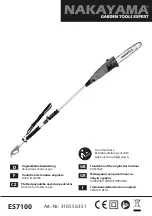
4.
Additional Safety Rules
e.
NEVER place your face or body in line with the cutting
tool.
•
NEVER place your fingers and hands in the path of the
sawblade or other cutting tool.
•
NEVER reach in back of the cutting tool with either hand to
hold down or support the workpiece, remove wood scraps,
or for any other reason. Avoid awkward operations and hand
positions where sudden slip could cause fingers or hand to
move into a sawblade or other cutting tool.
•
DO NOT perform any operation “FREEHAND” — always
use either the rip fence or the miter gauge to position and
guide the work.
•
NEVER use the rip fence when crosscutting or the miter
gauge when ripping. DO NOT use the rip fence as a length
stop.
•
NEVER hold onto or touch the “free end” of the workpiece
or a “free piece” that is cut off, while power is “ON” and/or the
sawblade is rotating.
•
Shut “OFF” the saw and disconnect the power cord when
removing the table insert, changing the cutting tool, removing
or replacing the blade guard, or making adjustments.
•
Provide adequate support to the rear and sides of the saw
table for wider or long workpieces.
•
Plastic and composition (like hardboard) materials may be
cut on your saw. However, since these are usually quite hard
and slippery, the anti-kickback pawls may not stop a kick -
back. Therefore, be especially attentive to following proper
set-up and cutting procedures for ripping. Do not stand, or
permit anyone else to stand, in line with a potential kickback.
f.
If you stall or jam the sawblade in the workpiece, turn saw
“OFF”, remove the workpiece from the sawblade, and check
to see if the sawblade is parallel to the table slots or grooves
and if the spreader is in proper alignment with the sawblade.
If ripping at the time, check to see if rip fence is parallel with
the sawblade. Readjust as indicated.
g.
NEVER gang crosscut — lining up more than one work -
piece in front of the blade (stacked vertically, or horizontally
outward on the table) and then pushing thru sawblade. The
blade could pick up one or more pieces and cause a binding
or loss of control and possible injury.
h.
DO NOT remove small pieces of cut-off material that may
become trapped inside the blade guard while the saw is
running. This could endanger your hands or cause a kick -
back. Turn saw “OFF” and wait until blade stops.
12. KNOW YOUR CUTTING TOOLS
Dull, gummy or improperly sharpened or set cutting tools can
cause material to stick, jam, stall the saw, or kickback at the
operator. Minimize potential injury by proper cutting tool and
machine maintenance. NEVER ATTEMPT TO FREE A
STALLED SAWBLADE WITHOUT FIRST TURNING THE
SAW OFF.
a.
NEVER use grinding wheels, abrasive cut-off wheels, fric -
tion wheels (metal slitting blades) wire wheels or buffing
wheels.
b.
USE ONLY RECOMMENDED ACCESSORIES.
c.
Crosscutting operations are more conveniently worked
and with greater safety if an auxiliary wood facing is attached
to the miter gauge. (See Page 26).
d.
Make sure the top of the cutting tool rotates toward you
when standing in normal operating position. Also make sure
the cutting tool, arbor collars and arbor nut are installed pro p -
erly. Keep the cutting tool as low as possible for the oper -
ation being performed. Keep all guards in place whenever
possible.
•
Do not use any blade or other cutting tool marked for an
operating speed less than 5000 R.P.M. Never use a cutting
tool larger in diameter than the diameter for which the saw
was designed. For greatest safety and efficiency when rip -
ping, use the maximum diameter blade for which the saw is
designed, since under these conditions the spreader is near -
est the blade.
e.
Make sure the table insert is flush or slightly below the
table surface on all sides except for rear side. NEVER oper -
ate the saw unless the proper insert is installed.
NOTE AND FOLLOW SAFETY INSTRUCTIONS THAT APPEAR
ON THE FRONT OF YOUR TABLE SAW.
SM 2610008289 02-10:3310 Table Saw 2/2/10 8:38 AM Page 4





































